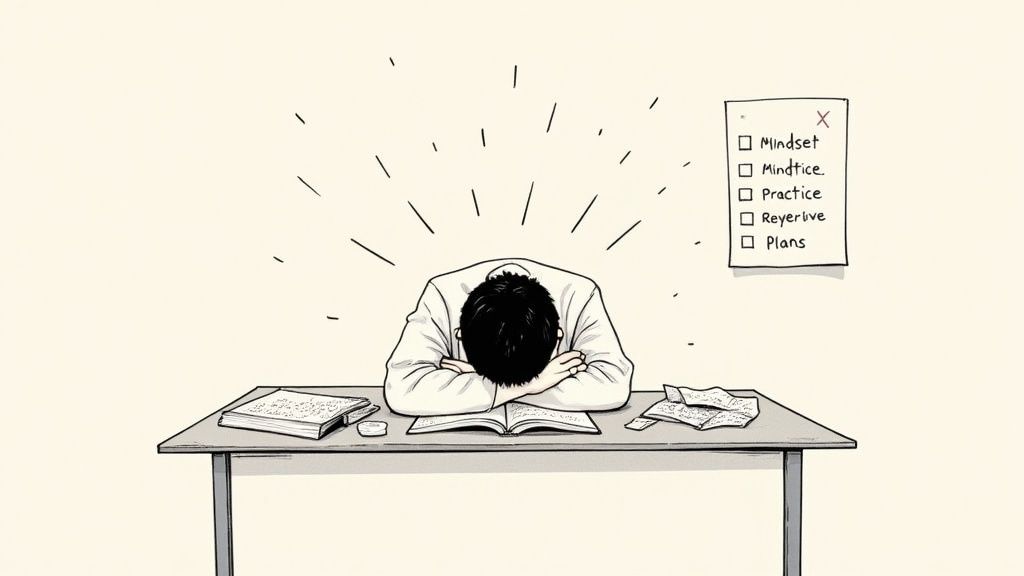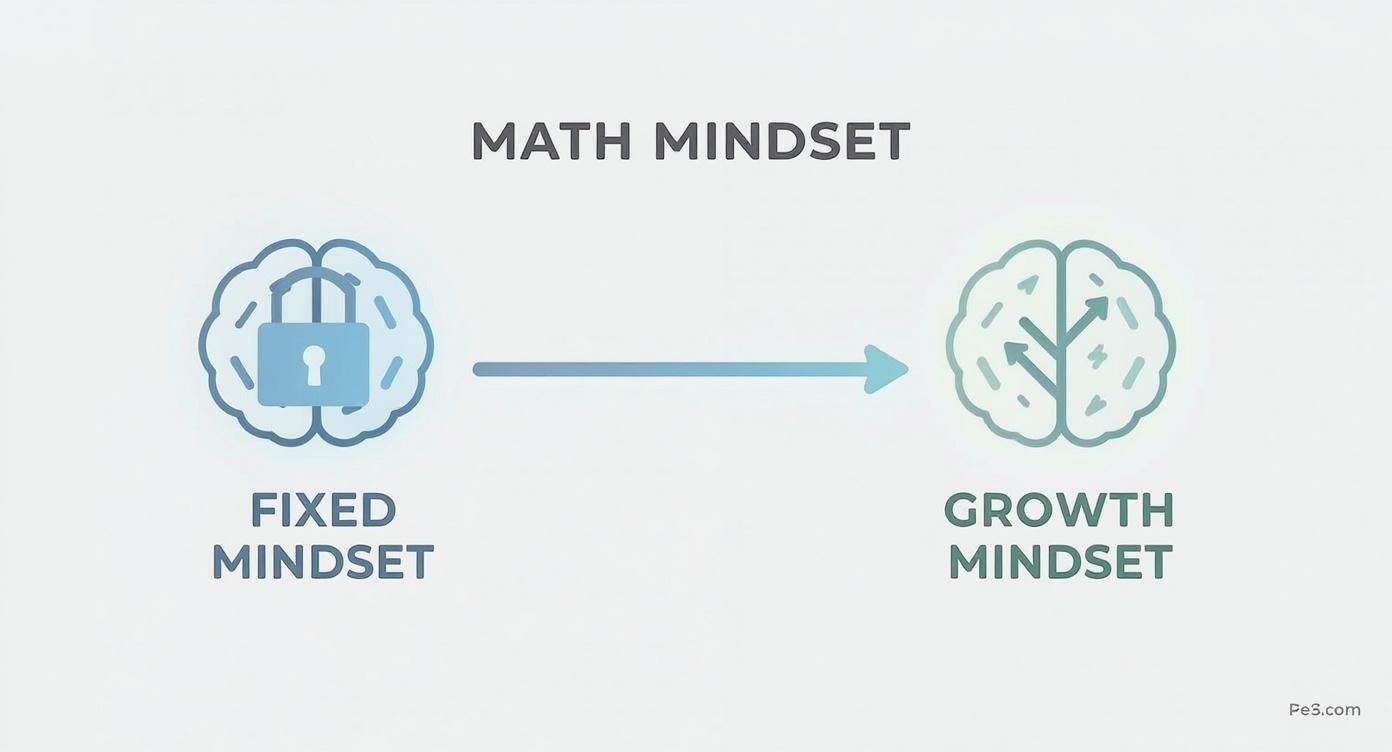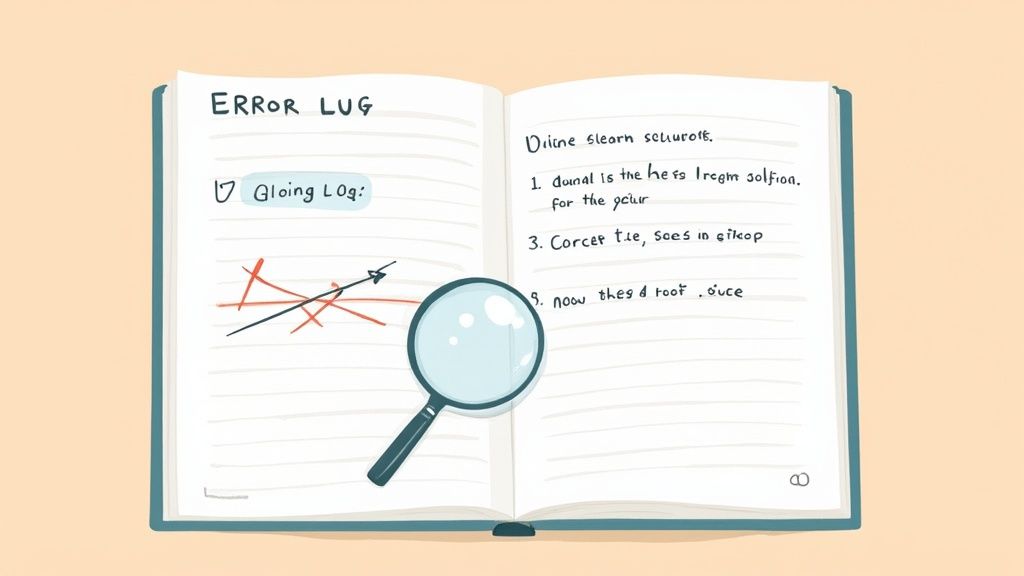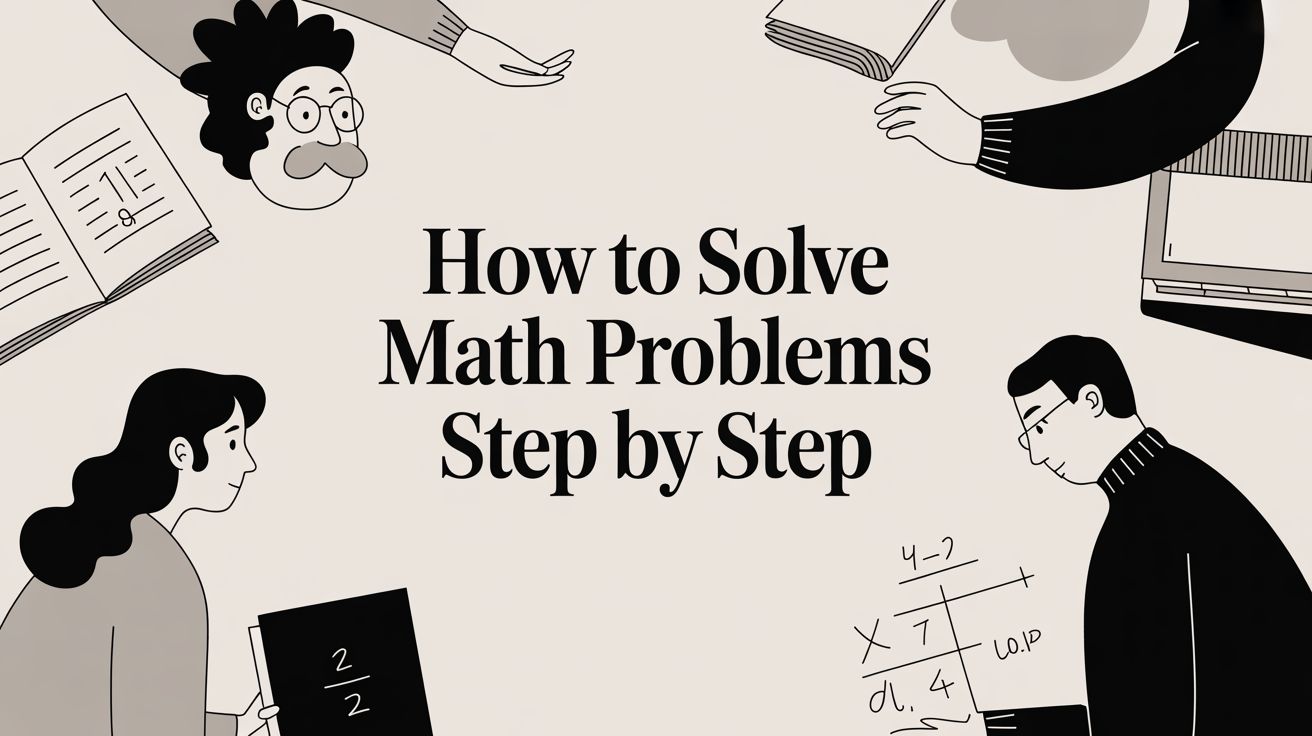How to Study Math Effectively and Actually Retain It
Discover how to study math effectively with proven strategies for active learning, smart practice, and strategic review that build lasting understanding.

Let's be real for a moment—staring at a math problem, hoping for a sudden spark of insight, is a losing game. If you want to actually get better at math, you have to move beyond passive learning (like rereading your notes for the tenth time) and dive headfirst into active problem-solving.
It’s all about building a tough mindset, tackling problems with a real strategy, and treating your mistakes not as failures, but as the most valuable clues you have for getting better.
Why Your Current Math Study Habits Aren't Working

Ever spent an hour rereading a chapter, feeling like you've got it down, only to freeze up on the very first homework problem? You are definitely not alone. The hard truth is that many of the study habits we're taught just don't cut it for a subject like math.
Math isn’t a spectator sport. It's a skill, and like any skill, it requires hands-on practice to develop.
That nagging feeling of being "bad at math" usually isn't about your brainpower; it’s a symptom of using the wrong tactics. Passive methods, like highlighting your textbook or watching a video of someone else solving an equation, create what's called an illusion of competence. You recognize the concepts, sure, but you haven't actually built the mental connections needed to solve a problem from scratch on your own.
This gap between recognizing and doing is where most math anxiety comes from. And it’s a massive issue. National trends show that tons of students label themselves as not being "math people" long before they even finish middle school. This isn't just a personal hurdle—it's a systemic one.
The 2022 Program for International Student Assessment (PISA) revealed a sobering statistic: U.S. 15-year-olds ranked significantly lower in mathematics than their peers in 30 other countries. Our national average is lagging. You can dig into these findings on math education from the Learning Policy Institute.
This data makes one thing crystal clear: the problem isn't usually the student. It's the approach. So, let's stop the self-blame and start building a better game plan.
Adopting a New Game Plan for Math
To really master how to study math, you need to reframe the entire process. It's time to ditch the myth that you're either born good at math or you're not. Think of it more like learning an instrument or a sport—it's a skill built through smart, consistent effort.
This guide will give you that strategy. It's built on three core pillars that, when combined, create real, lasting understanding and confidence.
This table gives a quick overview of what we're about to dive into. Think of it as your cheat sheet for a smarter math routine.
The Three Pillars of Effective Math Study
| Pillar | Core Principle | Key Action |
|---|---|---|
| Mindset | Your ability isn't fixed; it can grow with effort. | Shift from saying "I'm bad at this" to "What can I learn from this attempt?" |
| Active Practice | You learn math by doing math, not by watching it. | Work through problems, analyze solved examples, and use spaced repetition. |
| Smart Review | Mistakes are data, not failures. | Keep a detailed error log to identify patterns and target weak spots. |
By building your study habits around these three pillars, you can transform math from a source of frustration into a skill you can genuinely master. Each of these pillars is a crucial part of a system that actually works. Now, let's break down how to put each one into action.
Building a Resilient Mindset for Math
Before you even think about cracking open a textbook, let’s talk about the single most important part of the equation: your own head. Seriously. How you approach math has a massive impact on how well you learn it.
For so many people, the real enemy isn't trigonometry or differential equations. It's that nagging voice that says, "I'm just not a math person."
From "I Can't" to "I Can't... Yet"
That feeling usually comes from what psychologists call a fixed mindset. It’s the belief that you’re either born with a "math brain" or you're not. When you see a tough problem through that lens, a mistake feels like a final judgment on your abilities.
The key is to shift your perspective to a growth mindset. This isn't just about "positive thinking"; it's a fundamental understanding that your brain is like a muscle. The more you work it, the stronger it gets. Challenges become opportunities, and mistakes are just data showing you where to focus next.
It's a small but powerful switch in your internal script:
Instead of: "I got this wrong. I'm a failure."
Try: "Okay, this mistake is pointing out exactly what I need to work on."
Instead of: "I'll never get this."
Try: "I don't get this yet. What's another angle I can try?"
This simple change turns math from a high-stakes performance into a low-stakes process. It’s all about gradual, steady improvement.
How to Deal with Math Anxiety Head-On
Let's be clear: math anxiety is a real thing. It can literally hijack the logical part of your brain, making it impossible to think clearly. A growth mindset is your best tool for fighting back.
Here are a few practical ways to quiet that panic and get to work:
Tackle the Smallest Piece First: Staring at a huge, complex problem is instantly overwhelming. So don't. Just find the very first, tiniest step you can take. Maybe that's just writing down the "givens" or finding the right formula. Each small win builds momentum.
Focus on the Process, Not the Answer: Forget about just getting the right answer at the back of the book. Instead, focus on executing the steps correctly. Did you set up the equation right? Did you follow the order of operations? Celebrating these small procedural wins reinforces good habits and takes the pressure off.
The struggle you feel when wrestling with a tough problem isn't a sign that you're failing. That feeling is your brain forging new connections. It's the feeling of learning happening in real-time.
At the end of the day, everything else—from how you practice problems to how you take notes—is built on this foundation. Believing that you can improve with smart, focused effort is the first and most critical step. That resilience will carry you through the tough spots and turn confusion into real, lasting understanding.
Ditch Passive Reading and Start Actively Solving Problems
Here's the single biggest mistake I see students make: they treat math like a spectator sport. They read the textbook, highlight some formulas, and maybe re-watch a lecture, thinking the knowledge will just seep in. It won't.
Math isn't something you absorb; it's a skill you build by doing. You have to get your hands dirty. True learning happens when you move from passively reading to actively wrestling with problems. It’s about training your brain to see the patterns and understand the why behind each step, not just memorizing the how.
This shift in approach all starts with your mindset—moving from a fixed "I'm bad at math" mentality to a growth mindset where every challenge is an opportunity to get stronger.

As you can see, breaking free from that "I can't do it" thinking is what opens the door to real, lasting skill development.
Start by Reverse-Engineering Worked Examples
Before you dive headfirst into a pile of practice problems, try one of the most effective and underused strategies out there: studying worked examples. Find a similar problem that already has a complete, step-by-step solution laid out.
Your mission here isn't to memorize it. It's to become a detective and reverse-engineer the logic. As you go through each step, ask yourself critical questions:
- Why this formula? What clues in the problem pointed the original solver in this direction?
- What's the logic here? How does step two follow from step one? What was the goal?
- Is there another way? Could this have been solved differently? Why was this path the most direct?
This technique primes your brain to recognize the underlying structure of a problem. When you finally tackle a fresh one on your own, you're not starting from scratch—you've already got a mental blueprint to guide you.
Mix It Up with Spaced Repetition and Interleaving
Active problem-solving isn't about grinding through dozens of identical problems. It’s about smart, strategic practice. If you only do easy problems, you’ll never grow. But if you only attempt the impossible ones, you’ll just get frustrated.
The sweet spot is in the mix.
Use Spaced Repetition to Build Long-Term Memory
Don't just drill a new concept into the ground for one night and then forget about it. A much better approach is spaced repetition. Instead of doing 20 problems on a single topic, do a few from today's lesson, a couple from last week's, and maybe even one from a month ago.
By revisiting concepts at increasing intervals, you force your brain to retrieve the information right when it’s about to fade. This act of retrieval is what cements knowledge in your long-term memory, making it far more powerful than last-minute cramming.
For instance, after you learn how to solve logarithmic equations, don't just put them away. Do a few practice problems two days later, then again a week later. That’s how you make it stick. If you need a refresher on that topic, you can check out our guide on how to solve logarithmic equations.
Practice Like You Play with Interleaving
Another game-changing technique is interleaving. This simply means mixing different types of problems into a single study session. Instead of doing a block of Topic A, followed by a block of Topic B, you jumble them all together.
I'll be honest, this feels harder in the moment. It’s less comfortable than getting into a rhythm with one problem type. But that’s exactly why it works. It forces your brain to do the hard work of figuring out which strategy is needed for which problem. This is exactly the skill you need on an exam, where everything is mixed up.
This method also mirrors how math is actually used. Top-performing students around the world are taught to identify the right tool for the job, not just execute a known procedure. It's about developing the mental flexibility to face any problem that comes your way.
Using Your Mistakes to Master Concepts

If active problem-solving is the engine that drives you forward in math, then your mistakes are the fuel. I know how frustrating a wrong answer can feel in the moment. But every single one is a bright, flashing arrow pointing directly to a gap in your understanding.
Learning to study math effectively really means learning how to see these errors not as failures, but as your most valuable data points.
Ignoring your mistakes is like trying to find your way through a new city without a map—you just end up making the same wrong turns over and over again. What you need is a system to analyze, correct, and actually learn from them so you don't fall into the same trap twice.
Creating and Maintaining an Error Log
This brings us to what I consider the single most powerful tool in any math student's arsenal: an error log. This isn't just a list of wrong answers. It's a dedicated notebook or digital document where you become a detective, investigating your own learning process.
The idea is simple. Anytime you get a problem wrong—on homework, a quiz, or a practice test—you don't just glance at the right answer and move on. You stop and document it. This simple act forces you to confront the why behind the mistake, which is always more important than the mistake itself.
For each entry, you’ll want to capture a few key details:
- The Original Problem: Write out the full question.
- Your Incorrect Solution: Show your work, exactly as you did it the first time.
- The Root Cause Analysis: This is the most crucial part. Why did you get it wrong?
- The Correct Solution and Process: Write out the correct steps and explain why they work in your own words.
Analyzing the Root Cause of Your Mistakes
When you get to the "root cause" part, try to be specific. From what I've seen, most math mistakes fall into one of three buckets. Figuring out which bucket your error belongs to helps you target your practice with laser precision.
- Conceptual Error: You flat-out misunderstood the core idea. Think trying to factor a quadratic equation as if it were a linear one.
- Procedural Error: You understood the concept but fumbled one of the steps. The classic example is forgetting to distribute a negative sign to every term inside a set of parentheses.
- Calculation Error: You knew the concept and the procedure but made a simple arithmetic slip-up, like adding 2 + 3 and somehow getting 6.
An error log transforms a discouraging red 'X' from a judgment into a diagnostic tool. It’s your personalized roadmap, showing you exactly where to focus your energy for the biggest improvement.
An Error Log in Action
So, what does this look like in practice? Let's take a common algebra problem. Imagine you were asked to solve for x in 3(x - 4) = 15 and your first attempt didn't work out. Here’s how you'd break it down in your error log.
Sample Error Log Entry
| Section | Content |
|---|---|
| Problem | Solve for x: 3(x - 4) = 15 |
| My Wrong Answer | 3x - 4 = 15 -> 3x = 19 -> x = 19/3 |
| Root Cause | Procedural Error. I forgot to distribute the 3 to the -4 inside the parentheses. I only multiplied it by the x. |
| Correct Process | 3(x - 4) = 15. First, distribute the 3 to both terms: 3*x - 3*4 = 15, which simplifies to 3x - 12 = 15. Then, add 12 to both sides to get 3x = 27. Finally, divide by 3 to find x = 9. The key is realizing the number outside the parentheses multiplies everything inside. |
As you build this log over time, it becomes your ultimate, personalized study guide. Before an exam, spending an hour reviewing your error log is exponentially more effective than just rereading the textbook. You're tackling your own specific weak spots, systematically turning them into strengths.
Using Tech as Your Personal Math Tutor
https://www.youtube.com/embed/IvXZCocyU_M
Mistakes and wrestling with problems are your best teachers, but let's be real—sometimes you just get stuck. In those moments, technology can be an incredible ally, acting as a personal tutor that’s available 24/7. The trick is to use these tools to actually build understanding, not just to find a quick answer and move on.
Modern tools like Feen AI are built specifically to guide you through the problem-solving process. Instead of just spitting out the final solution, they can show you the step-by-step logic. This is a lifesaver when you’ve hit a wall on a tough homework problem and your professor's office hours are days away.
We're seeing a huge shift in how math is taught effectively. AI-powered virtual tutors are making personalized learning a reality, moving away from passive lectures toward active, student-centered learning. This approach statistically boosts both interest and achievement by focusing on motivation and real-world understanding. You can find more insights on these educational trends on brighterly.com.
Getting Unstuck Without Cheating Yourself
The real power of an AI math helper isn't in getting the answer; it's in learning how to find the answer on your own next time. Your goal is to develop independent problem-solving skills, and technology should support that, not replace it.
Here’s a smarter way to use these tools:
- Tackle the problem solo first. Give it a genuine effort. Use your notes, your textbook, and what you remember from class.
- Find your exact sticking point. Don't just say, "I'm stuck." Pinpoint where you got lost. Is it the initial setup? A specific algebraic manipulation? A forgotten formula?
- Ask for a targeted hint, not the solution. Upload a picture of your work and ask something specific. Try, "What's my next logical step here?" or "Can you explain why the quadratic formula is the right tool for this problem?"
This method turns the AI from a simple answer key into a true collaborator. You’re still doing the critical thinking, but you have a guide to nudge you in the right direction when you’re truly lost.
Generating Unlimited Practice and Summarizing Notes
Beyond getting unstuck, AI tools offer a couple of other game-changing benefits for any math student. These features help you reinforce what you know and make your review sessions way more efficient.
First, you can create your own custom practice worksheets. If you're shaky on a specific concept, like trigonometric identities or integration by parts, just ask the AI to generate ten similar problems. This gives you the targeted practice you need to turn that weak spot into a strength.
Second, AI is a beast at condensing complex information. You can upload a photo of your lecture notes or even a dense textbook chapter and ask for a summary of the key concepts, formulas, and definitions.
Think of it as creating an instant cheat sheet. This process forces you to zero in on the most critical information, making your study and review time much more focused and productive.
Here’s a look at how clean and simple the interface is for tools like Feen AI when you need to upload a problem.
As you can see, it's a straightforward, chat-based format where you can drag-and-drop or upload an image of your math problem. This kind of intuitive design means you spend less time figuring out the tool and more time learning the math.
Ultimately, bringing technology into your study routine is about working smarter. When you use these tools the right way, they provide personalized support that deepens your understanding and builds lasting confidence. For more ideas on effective study habits, you might want to explore our other articles on the Feen AI blog.
How to Build a Study Routine That Actually Sticks
Look, all the fancy study techniques on the planet won't help if you don't have a solid routine to apply them. A good study plan isn't about magically finding more hours in the day—it's about making the hours you already have count. This means swapping those long, painful cramming sessions for shorter, more frequent, and laser-focused bursts of effort.
When it comes to mastering math, consistency is your best friend. Your brain builds understanding by revisiting ideas regularly, which strengthens the neural pathways for that information. A chaotic, last-minute approach is a recipe for stress and forgetting everything after the test. A steady, predictable routine, on the other hand, builds genuine confidence and a much deeper grasp of the material.
Structure Your Study Time for Peak Performance
To really get the most out of your study sessions, you need a system that prevents you from burning out. One of the most effective I've seen is the Pomodoro Technique. It sounds simple, but it’s a game-changer for staying focused.
Here’s the basic idea:
- Pick one specific task (e.g., practice problems from Chapter 5).
- Set a timer for 25 minutes and work on only that task. No phone, no notifications, no distractions.
- When the timer goes off, you must take a 5-minute break. Get up, walk around, grab some water—do anything but work.
- After four of these 25-minute cycles (or "Pomodoros"), take a longer break, maybe 15-30 minutes.
This rhythm of focused work followed by a short break keeps your mind sharp. It transforms a daunting two-hour study block into manageable chunks, making it way easier to just get started. It also trains your ability to concentrate, a skill that's just as crucial as knowing how to write an essay quickly when you're juggling multiple deadlines.
You can get more done in 90 minutes of focused effort than in three hours of half-distracted studying. The goal here is quality over quantity—it’s about effective work, not just clocking in hours.
Sample Weekly Math Study Schedules
Everyone's schedule is different, so your routine needs to work for you. Seeing a few examples, however, can give you a great starting point. The trick is to block out short, recurring chunks of time that are reserved just for math.
Here’s what this might look like for a couple of different students:
For a High School Calculus Student:
- Monday (45 min): Review the weekend's homework. Go through your error log and fix any mistakes.
- Tuesday (60 min): Do two Pomodoros on the new concepts from class.
- Wednesday (45 min): Spaced repetition time. Tackle some practice problems from last week's topic to keep it fresh.
- Thursday (60 min): Two more Pomodoros dedicated to tonight's homework.
- Sunday (75 min): Quick review of the entire week's material and a brief look ahead to what's coming next.
For a College Statistics Student:
- Mon/Wed/Fri (60 min each): Right after class, knock out two Pomodoros to go over lecture notes and get a head start on the problem set.
- Tuesday (75 min): Dive into the error log. Then, do some interleaved practice, maybe mixing different types of hypothesis tests to challenge yourself.
- Saturday (90 min): Block out time for a longer-term project or a more comprehensive review of the last couple of chapters.
Notice a pattern? Neither of these schedules relies on cramming. They're all about consistent, active work with the material, which is the key to staying on top of things and never feeling like you're falling behind.
Got Questions? We've Got Answers
Even with the best study plan in the world, questions are going to come up. It's just part of the process. Let's tackle some of the most common hurdles students run into when they're trying to nail down how to study math for real results.
How Much Time Should I Actually Spend on Math Every Day?
Forget about a magic number. The real key is consistency, not cramming. A focused 45-60 minute session every day is far more effective than trying to survive a 4-hour marathon once a week. This steady rhythm gives your brain time to actually process and store what you're learning, preventing that dreaded burnout feeling.
Now, if you're wrestling with something like advanced calculus or statistics, you might need to bump that up to 90 minutes. But always remember, it's about the quality of your focus. A solid 45 minutes of genuinely working through problems is worth more than three hours of just staring at your textbook.
What’s the Smartest Way to Review for a Big Math Test?
Start at least a week out. Seriously. Your first stop should be that error log you’ve been keeping—it's a goldmine of information on what you need to patch up.
Instead of just rereading your notes (a classic mistake), you need to get your hands dirty. Go back and re-solve problems from old homework assignments and quizzes.
Pro Tip: Build yourself a practice test. Mix up problems from different chapters, set a timer, and try to replicate the real exam conditions. The last day or two before the test shouldn't be for learning new things; it's for reviewing your key formulas and cementing the core concepts you already know.
I Get It in Class, but My Mind Goes Blank on the Homework. What Gives?
This is probably the most common frustration in all of mathematics, and it points to one thing: a gap between passive understanding and active application. When you're watching a teacher solve a problem, it makes sense. But doing it yourself is a whole different ballgame.
First, find a similar problem in your notes or textbook that has a full solution. Cover it up and try to work through the steps on your own. See where you get stuck.
Then, go back to your homework problem and just try to figure out the very first step. That struggle, that moment of being stuck, is where you're actually building new neural pathways. If you're completely lost, use a tool to get a hint for just the next step, not the whole answer. This helps you build the muscle for figuring things out on your own.
Ready to bridge that gap between confusion and confidence? Feen AI provides the clear, step-by-step guidance you need to break down tough problems and finally understand the why behind the math. Upload your homework and get the explanations you've been looking for at https://feen.ai.
Relevant articles
Discover how to solve systems of linear equations with clear steps, example problems, and practical tips to boost your confidence.
Struggling with math? This guide breaks down how to solve math problems step by step using a proven framework, real examples, and modern tools.

